

CHRISTIAN LEADER

Scientific Curiosity ICOMB interview Atlas Shrugged




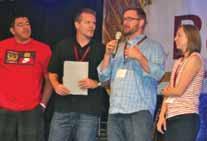
Awedding I attended at the beginning of the summer reminded me why the things that we do together as U.S. Mennonite Brethren are important. At the end of the marriage ceremony the pastor invited an older woman from the bride’s congregation and a younger man from the groom’s home church to offer prayers for the couple.
These two individuals had served as Ministry Quest (MQ) mentors for the bride and groom when as high school students they participated in this yearlong leadership program. The purpose of MQ is to help young people understand God’s call on their lives. The fact that this couple asked their MQ mentors to be part of their wedding day told me how important this process was to them.
Ministry Quest is just one example of the things we do better together as U.S. Mennonite Brethren. Preparing young people for ministry in the church and in their chosen professions is a historical priority for us. And so owning a college and a university together makes sense; it’s something few congregations could manage on their own.
Hearing firsthand reports is one of the benefits of attending a national convention.

“ Connie Faber Editor
Working together to equip pastors, missionaries and church planters allows us to be more efficient, to develop our theology in community and to highlight the distinctive Anabaptist and evangelical theology we hold as U.S. Mennonite Brethren.
When we band together as local congregations, regardless of size and location, we have the resources to plant churches in our own country and around the world. Publishing online and in print is affordable when we work together. We can offer low-interest loans to churches when we pool our financial resources.
Delegates and guests who attended Conection 2012, the biennial USMB delegate convention held last month in Omaha, Neb., heard from about a dozen people that lead national and binational MB endeavors. Hearing firsthand reports, including those of MB Mission representatives pictured above, is one of the benefits of attending a national convention.
We leave national events excited and inspired. We leave more familiar with the things we do together and better equipped to introduce Mennonite Brethren resources, programs and ministries to our home congregations. There is a good reason why when asked about a national convention many of us say, “You had to be there.”
Providing delegates with the information we need to champion Mennonite Brethren ministries in our home congregations is a key goal of biennial USMB delegate conventions. And Conection 2012 deserves high marks for accomplishing that objective. No, the business sessions weren’t perfect as there is room always for improvement. But delegates left Omaha excited about the work of USMB and its partner agencies.
And so I encourage individuals and congregations to begin planning now for the 2014 convention. Watch for announcements as to the date and location and then mark your calendars—both at home and at church. Start saving for Conection 2014. Biennial USMB conventions are expensive events, but the benefit to local churches is significant enough that it’s worth helping delegates cover some of the costs. Let’s encourage the congregations we are part of to set aside funds now to help our delegates attend Conection 2014.






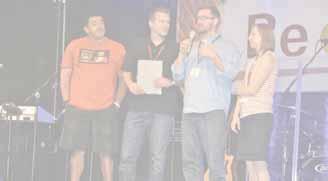









Bob Freye

The woman held the door open while her cat stood like a statue in the middle of the doorway. The tiny cat nose processed an infinite variety of smells coming from the yard, from the enticing aroma of tiny prey to the offensive stink of automobile exhausts.
“Come on, Patches,” the woman groaned. “Are you in or out?”
The tone was unmistakable. The woman was impatient. She lacked the cat’s acute awareness of her surroundings, so naturally she would think the decision should be a simple one.
The cat flicked her tail as she turned and walked slowly into the house. The door slammed, and the woman went back to the little table and the soft chair by the window.
The cat thought about jumping to the windowsill and then onto the woman’s shoulder, but she recognized the ritual. The woman would not linger long in the soft chair. So the cat wandered away to find a more suitable place to nap.
The woman picked up the Bible from the table, placed it in her lap and began to read again from the beginning of the psalm. She liked the majestic language of the psalms, but they could be impractical. As her eyes raced past a mention of the beauty of God’s presence, her ears missed the still, small voice that called out to her.
“Emily, are you in or out?”
Clattering background noises surrounded her: the details of her children’s upcoming concert at school and the nagging cost of her parents’ medications. She wondered if God didn’t sometimes try to make things too simple. He was apparently oblivious to the complexities of a suburban family’s world. Life wasn’t easy.
The voice was impatient. “Emily, in or out!”
A vague hint of something remarkable stirred within her, but she pushed it away. She laid the book back on the table—too much to do. She would return later, when she had more time.
She carried freshly washed clothes to the bedroom, where the cat had discovered a sweater folded neatly at the foot of the bed. Patches was curled up in a tight ball, purring softly as she sank deeper into the folds of the sweater.
“Lucky you,” the woman sighed.
The cat agreed. She pressed her paws into the yarn and stretched. Any lingering thoughts of the outside world were overshadowed by the glory that seemed to fill the woman’s house.
As Emily folded clothes on the bedspread, her cat purred, “I’m in!”
Bob Freye is senior pastor of Community Bible Church in Mountain Lake, Minn.

“One thing I ask of the LORD, this is what I seek: that I may dwell in the house of the LORD all the days of my life, to gaze upon the beauty of the LORD and to seek him in his temple.” Psalm 27:4
CHRISTIAN LEADER
August / September 2012
Volume 75 • Number 4
Connie Faber EDITOR
Myra Holmes ASSISTANT EDITOR
Shelley Plett
GRAPHIC DESIGNER
Christian Leader
Cover Photo: Iglesia Agua Viva worship team members
The Christian Leader (ISSN 0009-5149) is a gathering place for the people, passions and mission of U.S Mennonite Brethren. The Christian Leader is published bimonthly by the U.S. Conference of Mennonite Brethren Churches. However, the opinions expressed here are not necessarily those of the church as a whole.
COPYRIGHT The articles printed in the Christian Leader are owned by the CL or by the author and may not be reprinted without permission. Unless noted, Scripture quotations are from the New International Version.
READER PARTICIPATION Letters to the editor should be 300 words or less and on one subject. Letters must be signed and include the writer’s city and state. Letters will be edited for clarity, appropriateness and length. Letters will be published, as space allows, unless marked, “Not for publication.” Readers interested in contributing essays for In My Humble Opinion and First Person should contact the editor. Freelance article submissions are welcome; a SASE must accompany articles.
SUBSCRIPTIONS $10 for six issues and $20 for 12 issues ($15, $30 in Canada; all other countries $25 for six issues); $1.50 per copy
CORRESPONDENCE: All correspondence, including subscription questions and address updates, should be addressed to Christian Leader Box 155, 107 N. Main, Hillsboro, KS 67063-0155 Phone: 620.947.5543
E-mail: christianleader@usmb.org
MEMBERSHIP The Christian Leader is a member of the Evangelical Press Association and Meetinghouse, an association of Mennonite and Brethren in Christ editors.
POSTMASTER Send address changes to Christian Leader, Box 155, Hillsboro, KS 67063. Periodicals postage paid at Hillsboro, Kansas.
The Christian Leader is published by

U.S. Conference of MB Churches

Ed Boschman USMB executive director
ebed@usmb.org
Saying together what we believe
Reading through our then newly revised Confession of Faith at the last U.S. and Canadian binational convention in Wichita the summer of 1999 is a warm memory for me. The reminder that we are on a mission that will conclude when “all God’s children will be united with Christ…and reign with him in glory… and the redeemed will be gathered into the new heaven and new earth…and God will be all in all” was charged with the Spirit’s presence.
It was a rare, energizing and motivating experience to corporately think ahead to the grand finale at the culmination of the review of our common understanding of the faith. But here is the thing: The last page can only be fully satisfying when the rest of the story sets it up. Yes, the ending matters in a big way, but the journey is what takes us there. Every epic story is like that. Realities, truths, values and commitments must be clarified and battles must be waged before the culminating rescue. What’s more, the terms of reference for that saga are of high importance.
So it is with our Confession. The articles of belief preceding the denouement are critical to the story. But here is another thing: Most of us don’t have much of a clue what those other 17 articles of faith say. Very few of us would be able to list the topics, let alone know any content.
All 18 articles in our Confession matter, but we don’t know them. We have an abbreviated version and a sidewalk summary. But even the latter assumes too large a sidewalk. My contention is that we need a summative version of what we believe so that at the very least our pas-
tors-teachers-leaders are able to pass a pop quiz on it.
How might we summarize our EvangelicalAnabaptist beliefs? Some months ago, I heard a story out of Colombia that is stimulating. All our Colombian MB brothers and sisters know their sidewalk version: “Jesus is the center of our faith. The community is the center of our life. Reconciliation is the center of our work.” What’s more, they actually recite it together. That is nothing short of fabulous. A church that actually knows in summary form what they believe. That means they can consciously aim to live their lives on clear mission. What if we all could do that?
USMB leaders have been interacting through social media to try to abbreviate what it is that USMB believe. Here is what we have come up with:
We are Bible believers.
We are Christ-centered and Spirit-led. We encourage a believe-obey relationship with Jesus in both word and action.
We partner in believers church communities. We live and serve as agents of reconciliation in all relationships.
Now it’s your turn. How does this look, sound and feel to you? Is there something missing that must be added? Should it be further abbreviated?
Can we learn to say this together? Are you willing to carefully and prayerfully think this through? We’d love to hear from you. Reach me at ebed@usmb.org.
How might we summarize our Evangelical-Anabaptist beliefs? USMB leaders have been interacting through social media to try to abbreviate what it is that USMB believe. What do you think of our summary?
Defining godly manliness
Iread and reread the “Blowing Stuff Up For God’s Glory” article (June/July Christian Leader), sure I was missing something. For 51 years, I’ve been married to David, someone who has restored a Model A Ford but never beaten a car to death; has never owned a gun; enjoys a spicy Indian vegetarian meal and says the thought of deep-fried Twinkies and Oreos nauseates him. I see him more as a “love, joy, peace, patience, kindness, goodness, faithfulness, gentleness, self-control” sort of person and thought that was what “godly manliness” was all about. And “godly womanliness,” for that matter.
Lorma Kroeker Wiebe Kearney, Neb.
Man Day not for everyone
The responses we have received from the Mennonite Brethren community about Man Day have been incredible. Men and women from across the country have made inquiries about how to participate, support and organize church men’s events around Man Day. We look forward to growing the fellowship of Man Day and the additional capacity to provide clean water to Niger.
I found the critical responses to the article posted online to be instructive and a good reminder of the diversity within our denomination. Man Day may not be for everybody. We get that. The church is made up of many different approaches to delivering the same message of Christ, salvation, fellowship and missions. We have found a niche that works extremely well for a wide cross section of men and our intended purpose doing so in an environment that builds up men as God intended us to be, distinctively male.
It is critical that we continue to create new and relevant events as a church to live out our MB mission: “We are one family, with one Lord, committed to one mission: the transformation of individuals, families and communities.”
Thanks for covering our event and the kingdom work in Niger.
Brent Kroeker Enid, Okla.
Man Day view of godly masculinity disappoints
Ifound the coverage given Man Day (“Blowing stuff up for God’s glory,” June/July Christian Leader) disappointing and distressing. Man Day is described as an effort to reclaim “godly masculinity,” and that the focus and activity of the event reinforces worldly, cultural stereotypes of hyper-masculinity that produces action and attitudes that are not biblically grounded and ultimately antithetical to the fruit of the Spirit. Participants claim independence from the “garbage society tells us” about masculine character, but their resulting construction of masculinity is a physical construct, a tough guise, a projection of power and control through violence and aggression that is derived from culture’s very definition of what it means to be a man.
Man Day distorts the true meaning of the gospel message for men and reinforces dangerous masculine stereotypes that are harmful not only to the spirit of the participants but to the health and well-being of their community. Aside from being an absolute fallacy, the idea that “aggression is part of the masculine design” gives men an excuse, if not a justification, for violent, destructive behaviors. Women, children and communities become victims of male-perpetrated violence that is excused as part of an innate masculine aggression. The further projection of this dangerous culturally based definition of masculinity through the use of weapons, particularly the “buffet of guns,” leaves me speechless.
I am unsure how these self-destructive, communitydamaging attitudes and actions came to be described as godly by these man and your magazine, but I would challenge us all to consistently examine the life of Christ as our model and the fruit of the Spirit as our helper in order to develop a model of masculinity that is both biblical and healthy.
Ray Dinkins Grants Pass, Ore.
The Christian Leader welcomes letters to the editor. Letters should be 300 words or less and on one subject. Letters must be signed and include writer’s city and state. Letters will be edited for clarity, appropriateness and length. Letters will be published, as space allows, unless marked “not for publication.” Readers wishing to respond to articles published electronically can post comments on our Web site (www.usmb.org/christian-leader) and can also leave comments on the CL Facebook page.
ICOMB appoints executive director, receives new conference
When Mennonite Brethren leaders from more than a dozen countries gathered May 16–19 in Liestal, Switzerland, for the International Community of Mennonite Brethren (ICOMB) annual summit, they accepted a new member conference and affirmed a new full-time executive director.
David Wiebe was officially affirmed as the full-time ICOMB executive director. Wiebe has served as the part-time interim director since January 2011 (see related story pages 15-16). He was executive director of the Canadian Conference of MB Churches from 2004–2010.
“David is the right man for this season of ICOMB,” says Ed Boschman, USMB executive director and the conference’s ICOMB representative. “We need to strengthen our structures and systems and put in place some good policies and procedures to provide stability for the growth and increased impact that ICOMB will experience in the coming years.”
A new Mennonite Brethren conference based in northern Thailand was received as an official ICOMB member, bringing the total membership to 20. Names and locations of “K Mission,” led by MB Mission worker PK, are veiled for security reasons; 15 pastors are currently in prison for their faith.
The 28 ICOMB representatives approved a mission statement: “ICOMB exists to facilitate relationships and ministries which enhance the witness and discipleship of member conferences.” They also heard reports from the Global Scholarship Fund Committee, discussed a membership protocol and affirmed continuing work on Mission Building Capacity. —Karla

Nikkel serves as head coach
Jeff Nikkel, pastor of Trailhead Church, a Mennonite Brethren congregation in Centennial, Colo., is serving as head coach of LEAD Coaching, a new USMB initiative to develop a network of coaches that will offer personal, oneon-one coaching for local church pastors and leaders. As the head coach, Nikkel will oversee the continued development of trained coaches and will provide overall leadership for the LEAD Coaching initiative.—Mission USA

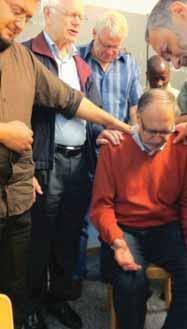




MB Foundation continues to GROW for 21st consecutive year
MB Foundation (MBF) assets grew in 2011 by 6.7 percent, with a year-end balance of $126,076,653. The USMB stewardship ministry experienced growth for the 21st consecutive year despite several forces that could have resulted in a declining asset base.
First, the market was basically flat in 2011. The standard asset allocation used for the majority of Foundation investment pools returned a meager 1.44 percent. This was slightly higher than the composite index used to measure performance, but with most pools paying out 5 percent, not nearly a great enough return to facilitate growth.
Secondly, MBF experienced a record number of estate distributions resulting in over $4.4 million released to charities in 2011. Sixty percent of these funds were distributed to Mennonite Brethren ministries to assist them in fulfilling their mission.
Despite the difficult economy, many individuals continue to be motivated to be generous. “We rejoice that we currently have over $120 million of charitable gifts in place to fund future ministry,” says Jon Wiebe, MBF president and CEO. To view the complete 2011 Annual Report, visit www.mbfoundation.com/financialprofile. —MBF
Braun
ICOMB
Commission approves new programs, leader
The Mennonite Brethren Historical Commission approved the development of several new grant programs and appointed a new executive secretary at its annual meetings June 8-9 in Fresno, Calif. The Commission is a jointly sponsored ministry of USMB and the Canadian MB Conference.
The new programs include an undergraduate student internship program and providing stipends for research on subjects related to Mennonite Brethren women. Jon Isaak was appointed the new executive secretary. He will add these duties to those he holds as director of the Center for MB Studies in Winnipeg, Man. He replaces Andrew Dyck, who begins work as a full-time faculty member with MB Biblical Seminary Canada. Since its formation in 1969, the Commission has helped coordinate the collection, preservation, and cataloging of Mennonite Brethren archival records, in cooperation with a network of Mennonite Brethren archival centers.—MB Historical Commission
16,000 children will miss school every day due to FEAR OF ATTACK or intimidation by other students.
90% of 4th through 8th graders report being victims of bullying.
1 in 7 students in grades K-12 is either a bully or a victim of bullying.
Source: National Education Association

5 minutes with...
Rachel Schellenberg
Dozens of Special Olympics medals and ribbons are among Rachel Schellenberg’s treasured possessions, but one award stands out from the others – her trophy from Kiwanis International’s 2011 Aktion Club speech contest. The 35-year-old from North Fresno (Calif.) Church is a leader in the Charis Community Aktion Club, part of a Kiwanis program for adults with disabilities. Her speech about leading the club’s relief kits project took third place in the international competition. It can be viewed at westcoast.mcc.org/programs/disabilitiesministries.


Were you nervous about making your speech in front of an audience?
It wasn’t scary. I was used to it because I practiced with my family when we were missionaries to Europe. When we went to churches I had to say how old I am and what I did over there.
What did you learn about leadership from being president of the Aktion Club?
When you are president you have to keep the people staying focused.
How did you get the relief project going?
I was president and I thought, it’s my year to get everything done. They made an announcement in church for relief kits and I brought it to my Aktion Club’s attention. They liked it and they said, “Good job to you, Rachel.”
What other service projects has your club been involved with?
We got to donate some Christmas presents for the poor people at the Ronald McDonald House and we helped Joni and Friends load up a truck with wheelchairs and walkers to send to Romania. It was a lot of lifting!

Do you serve at church too?
I help the grades one and two. We have three chairs—one for me and two for other kids where they have to sit till they can behave. They can trust me to keep the kids in line.
Interview by Kathy Heinrichs Wiest
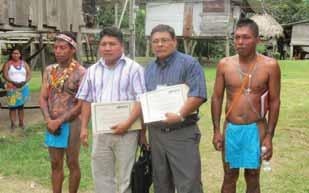



Land granted to Wounaans
Members of Panama’s Wounaan community have been granted official ownership of land on which lumber was being harvested against their wishes. Following a violent confrontation between loggers and the Wounaan that resulted in one death, Panamanian Mennonite Brethren requested prayer in early April for the peaceful settlement of land claims. Local church leaders sent an email June 5 to Mennonite World Conference saying, “Thanks to God, the right they were claiming for years is a reality today.”—MWC
FPU top school for Hispanic students
Fresno Pacific University (FPU), the Mennonite Brethren university headquartered in Fresno, Calif., has been named among the top 100 institutions for Hispanics by The Hispanic Outlook in Higher Education Magazine. Based on information from the U.S. Department of Education’s National Center for Education Statistics, colleges and universities across the U.S. are ranked by degrees awarded to students from a Hispanic background.—FPU
Tabor College raises $1 million
For the second consecutive year, Tabor College has surpassed the $1 million goal for its annual fund-raising campaign. This is the first time in school history that the Tabor Fund has been fully funded in consecutive years. Tabor is an MB-owned liberal arts college headquartered in Hillsboro, Kan.—TC

History volume now available
Mennonites in North America (1874-1910), the second volume of P.M. Friesen’s history of Russian Mennonites, was released in June by Kindred Productions, the publishing ministry serving U.S. and Canadian Mennonite Brethren, and the Centers for MB Studies in Hillsboro, Kan., and Winnipeg, Man. Friesen was a respected leader, teacher, minister, writer, political advocate and bridge-builder among Mennonites in Ukraine. In 1911, he completed (in German) the first—and still definitive— history of Russian Mennonites (1789–1910). For a limited time, purchases of the second volume will include a CD with digital copies of both the 1978 translation concerning Russia and the 2012 translation concerning North America. To order, visit www.kindredproductions.com. Karla Braun

ICOMB announces Japanese translation
The International Community of Mennonite Brethren (ICOMB) has announced completion of a Japanese translation of Knowing and Living Your Faith, a study guide offering commentary and questions on the ICOMB Confession of Faith. The Japanese translation joins several others: Telegu, Spanish, French and German.—ICOMB


Reflections on what motivates one man’s scientific endeavors


Why I ama planetaryscientist







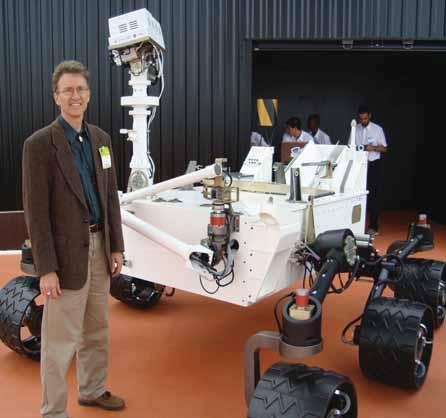






All systems were “go” for the rocket launch in the vacant lot behind our home in Mountain Lake, Minn. The year was 1971. My older brother and I, age 11, were the only ones present. I proceeded with the countdown: “3 2 1…Launch!”


A wisp of smoke curled from the bottom of the 28inch tall rocket as the igniter wire burned momentarily, and then the engine lit. Whoosh. The little rocket soared off the pad. The first stage separated and the second stage ignited with a pop, propelling the model out of sight. My brother, Doug, held the walkie-talkie that was receiving radio signals from the model on this maiden voyage of our transmitting payload, a new addition to our space-age hobby.
Fast-forward 40 years to November 2011. I am standing on a row of bleachers looking across a small Florida bay at a 200-foot-tall Atlas V rocket four miles away at Cape Canaveral. Surrounding me are more than 50 engineers who have designed and constructed the instrument our team delivered to NASA. About a thousand other people have joined us at the viewing stand on this sunny morning.
The national anthem finishes playing over the loudspeaker and the countdown clock shows less than a minute to go. The crowd rises to its feet as the final seconds tick off. At T = 0 we see a flame appear under the vehicle as it lifts off the pad, gains speed and passes through a cloud and then arcs out over the ocean. Moments later the sound of the massive rocket engines reaches our ears. From our safe vantage point the huge rocket looks uncannily like the small models Doug and I launched as kids. But this one is carrying a one-ton, six-wheeled rover the size of a car on its way to Mars.
On the rover is our laser instrument called ChemCam.
My involvement in the mission started in December 2004 when I received a call from NASA headquarters in Washington, D.C., telling me that our instrument had been selected for the next mission to Mars. I had submitted a proposal for a novel device to analyze rocks and soils on the red planet without ever having to drive up or touch the samples.
The technique works by firing laser pulses at samples from up to 25 feet away and recording the flash of light from the impact spot. The color of the light produced when a small amount of rock is vaporized tells us about the composition of the rock. The ChemCam instrument also takes high-resolution pictures of the samples it analyzes.
Half of ChemCam was built in New Mexico and the other half was built in southern France, funded by the French government. After testing the complete instru-
ment over the course of a couple of years, my team delivered the unit to the rover in late 2010.
And now the rover, named “Curiosity,” was on its way to Mars, set to land August 5. It is only the fifth to operate on the red planet. Curiosity is by far the biggest vehicle ever sent to Mars. At nearly 10 feet long and nine feet wide and weighing 2,000 pounds, it is the size of a small SUV.
Curiosity has an arm that extends over six feet in front of the vehicle and contains a drill, a brush and a microscope. The arm is also designed to deliver samples to two instruments inside the body of the rover. One will determine the mineral structure of rocks on Mars. The other will investigate elements like carbon and nitrogen to look for organic materials and will sniff for methane, a bi-product of living organisms. Curiosity also carries a weather station and stereo cameras.
Childhood dreams lead to career
For me this work is the product of a long-standing desire to explore Mars, going back to my childhood. I was strongly influenced by my older brother, Doug. Being somewhat of a genius, he studied the specific impulse of rocket engines when he was just a grade school kid. He also joined a national amateur astronomy group that made observations and reported them for use by professional astronomers. The organization didn’t ask our age, so we were allowed to join. No one knew we were just kids!
Doug went on to become a world-famous seismologist and a leader at a major university. Being two years younger than Doug, I was interested in everything he did, and so he shared his rocketry and astronomy hobbies with me. Although I never expected to, I ended up making a career in science as well.
Planetary science is not a field populated by many


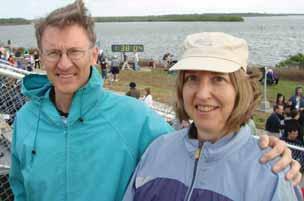
Scientist Roger Wiens (above) and his wife, Gwen, were among the crowd gathered at Cape Canaveral last November to watch the launch of a vehicle that will explore the planet Mars. The launch clock is visible in the background between the couple. Curiosity (left), the largest vehicle to be sent to Mars, landed Aug. 5 on the red planet. Among the instruments housed in the rover is ChemCam, a laser instrument that will analyze rocks and soil that was designed by Roger Wiens and a team from Los Alamos National Laboratory in New Mexico. Wiens is pictured with a full-scale model of the rover that was launched November 2011.
ROGER WIENS
evangelical Christians. What caused me to go into the sciences? First of all, it was providential. But four ideas have kept me going in my career.
Seeing my job as my mission. I believe God places us where we are for a purpose. When I was younger I assumed that my career should involve doing something overtly Christian, such as working in missions or doing relief work in a third-world country. As a young adult I spent a lot of time in prayer over my future.
But the opportunities that I expected in those areas never materialized. Instead, a job working for NASA fell into my lap and then another NASA job, and so on. I believe God wants us to do well what he calls us to do, so I have pursued excellence in my vocation.
Recognition that “the heavens are telling the glory of God.” This phrase is the beginning of Psalm 19, which goes on to say, “The skies proclaim the work of his hands. Day after day they pour forth speech; night after night they reveal knowledge… They use no words; no sound is heard from them. Yet their voice goes out into all the earth.”
One thing that I remember from going to church as a child is the front covers of the weekly bulletins. There was an inspiring picture: a majestic mountain; a lush, green meadow in spring; a mountain stream reappearing from under the winter snow or, after the Apollo Moon missions, a view of planet Earth from the Moon. Most often a psalm about God’s majesty accompanied the images.
If images inspire us to consider God’s greatness, how much more should the details behind these images inspire us? And so these details, summarily considered science, are the voice in Psalm 19 telling us of the glory of God. Altogether, science tells us of the greatness of God. We would do well to listen more.
Understanding that “all truth is God’s truth.” Philippians 4:8 encourages us to think on “whatever is true, whatever is noble, whatever is right, whatever is pure, whatever is admirable.”
Science is a search for truth about God’s creation. I believe God commends us to satisfy our curiosity about his creation through the study of science. This stands in contrast to the view that we have to guard ourselves against heresies taught in the name of science.
more of his nature. This is exploration with a far greater purpose than simply to satisfy our curiosities or to exploit new discoveries.
Compared to a century or more ago, we now know that the universe is vastly larger than was ever conceived in previous times; the human genome is amazingly more intricate than might have been fathomed; far more species exist on earth than thought possible; and living organisms inhabit more extreme places than we ever previously considered. Doesn’t that tell us something very exciting about the Creator? By bringing to light these amazing details we are pointing out the excellence of the One who brought about all of these things. That is worship.
Exploring the red planet
Getting back to the Curiosity mission to Mars, one of the primary goals is to determine the habitability of our neighboring planet. Was it ever hospitable for life? Once thought to be a dry and dead planet, we now know that there were rivers, lakes and likely oceans on Mars in the past. Sedimentary rock layers are piled several miles high, indicating the major role that water played in the past, similar to on earth.
One such mound of sedimentary layers is the destination for our rover. If we were to find evidence of past living organisms—single-celled microbes— would it be such a surprise? C.S. Lewis, the renowned Christian apologist of the last century, wrote an essay called “Religion and Rocketry.” In it he raises the question of whether it shocks us that God could create life on other worlds.
Unfortunately, Christians are often stuck not thinking creatively—outside the box—enough even though we have a multitude of examples of God’s creativity in how he interacted with people in the Bible. And so we need people like C.S. Lewis and scientists like Galileo, Newton, Kepler and others in our day, to think outside the box and to discover new things.
I hope you will join me in following the Curiosity mission as it explores Mars.


The real question in these situations is, “What is true?” Unfortunately, it seems that many believers are hesitant to really search out the truth in various areas of science. In my associations with scientists of all religious—and “nonreligious”—backgrounds, I find that most scientists are really searching for truth. Pursuing exploration as worship. No matter what motivation others have for doing science, we can do it to explore God’s creation, to understand
Roger Wiens is a senior scientist at Los Alamos National Laboratory in New Mexico. Over the last 25 years he has researched and given talks on various aspects of planetary science, from Jupiter’s moons to the composition of the Sun. Wiens received his training in Physics from Wheaton College and the University of Minnesota. Some of his work is highlighted in the emagazine, God and Nature, at http://asa3.org/zine/?cat=35. Readers can follow the action at the Curiosity rover’s website: http://mars.jpl.nasa.gov/msl/ or at the ChemCam instrument website: http://msl-chemcam.com/.
The Vocation Conver sation
by MIKE SPINELLI
When people are seeking direction in life, a good conversation may help them hear the voice of God
Garry could not imagine doing anything but teaching. He loved to help his students master mathematics. He did not want to be principal; he did not go into teaching to run a school. Though retired, Garry still loves to teach.
Garry almost missed his vocation. As a college freshman he wanted to do something else entirely. But after really exploring the other field, he decided to investigate education. Garry found his calling and never looked back.
I am thankful that Garry found his calling to teach—not everyone does. There are people that have a job but have not found their calling. Some might have been laid off by their last employer and wonder what has God given them to do. Students who graduated from high school and college last spring are wondering what course their life should be taking. All of them are wondering, “What is my calling?”
Our evangelical tendency is to associate “calling” with professional ministry roles like pastor or missionary. We speak of calling out people to ministry in the church, yet not in the day to day world. Our early spiritual siblings heard the voice of God calling them to their professions, whether it was as a butcher, baker or candlestick maker. Their vocation was a summons to be at work in God’s world for his pleasure.
Helping the searching
So how do we go about helping the high school student choose a college, the
Vocation and calling....
college graduate forge a future, the recently displaced find a new career or the unhappy worker find that calling they search for?
One way to start is to follow the example of our spiritual forbearers and fulfill our calling as a covenant community. Our Confession of Faith says that Mennonite Brethren are a people that “are mutually accountable in matters of faith and life. They love, care and pray for each other, share each other’s joys and burdens, admonish and correct one another. They share material resources as there is need” (Article 6).
As a matter of living our faith together, we are called as a community to help people who may be discerning or even struggling over their occupational direction.
We see the act of conversation in the Old Testament story of Samuel and Eli (1 Samuel 3). The Lord summons Samuel in the night and gives Samuel a warning of tragedy for Eli and the nation. Once Eli hears this word, he affirms the Lord’s message in Samuel, even though it means disaster for his family. Soon all Israel validates Samuel as a prophet and the Lord’s word came to Israel through him. Samuel is summoned to speak for the Lord and the community confirms it.
Just as Eli spoke affirmations to Samuel (in spite of the ill message for him), we have the opportunity to speak encouragement to someone seeking vocational direction. Our shared value of living in community often runs up against the cultural value of individualism. Each person






/



Vocation is defined as “a summons or strong inclination to a particular state or course of action; especially a divine call to the religious life,” or “the work in which a person is employed, e.g. their occupation.” While we tilt the meaning toward the clerical profession, the sense of anyone’s occupation being a vocation, a spiritual calling or summons is attested to in the early 16th century. Vocation has as a root the same word as voice. This gives us the sense of a profession as a calling and not simply a way to earn a living. So what are you called to?
Sources: http://www.etymonline.com/index.php?term=vocation; http://dictionary.reference.com/browse/vocation; http://www.merriam-webster.com/dictionary/vocation
is expected to figure vocational things out on his or her own. If an individual wants help, he or she can research. If advice is needed, there are people to consult. In the end, each individual must forge ahead and will rise or fall on his or her own choices.
The covenant community offers something from which the rugged individual can benefit. While we recognize that each individual must make the final decision, the wisdom and insight from trusted adults and friends weave a safety net of support and direction that questioning teens and seeking adults can fall into and know they are not alone.
I have witnessed this happening in the life of my oldest daughter, who will graduate from high school in 2013. We have spoken often over the years about what she wants to do and where she might go to school. People close to our family also speak into her life. The questions are not all resolved, but the conversations and the affirmations of her gifts and skills continue to flow.
Listening and talking
I believe the best way for the community to help a person discern his or her calling is through mutual listening and talking together. The community offers the gift of a willingness to enter into conversation while the individual is then asked to receive this gift with humility and joy.
Conversations with people making life decisions should be intentional. Engage the jobless or the searcher in conversation about where the hunt is taking them and what doors are opening and closing. Ask the young adult about graduate school or job opportunities. Where are they in the journey and what could you offer them in the way of help or discernment?
We show respect to each other by not making declarations. Plan to be reflective, not imperative. Ask questions that invite dialogue and good conversation. Affirm the gifts and skills you see in the other person. Advice should be sparse and usually given only if invited or if given permission to speak it. While being affirming, do not be shy about raising real concerns or pointing out challenges.
This is especially helpful when a person does not know what direction to move. These clarifying conversations may help spark thoughts the seeker has never considered. The affirmations can help lift a person paralyzed by the hopelessness of his or her situation.
As you help the individual clarify their vocation, avoid stating what you believe the person should do. I spoke with a young lady who knew exactly what she was called to do from the time she was eight. Even if I thought she should do something else, she was determined to follow her call into education. Any pronouncements on her calling would not have helped her find her true vocation. It would only set her on a road to fulfilling someone else’s vision.
There is room to call people to be realistic about what is not a gift or skill. Affirming the choice to go into a profession where he or she will certainly languish because of personality or lack of skills would not demonstrate love. If someone is clearly not an accountant but they want to go become a CPA, ask them to talk about their motivation. Help them discover what is not consistent between that vocation and who they are as a person.
I have wrestled with my calling in recent years. In this season of life I am not doing what I trained to do. Yet, I have found opportunities to fulfill my calling as a teacher and mentor. I have also been in a season of discovering the depth of the calling the Lord spoke into me to help the church in this season of cultural change.
I have not totally grasped what it looks like, so I continue to talk with people who know me and work out how my calling is best expressed right now. I am looking forward to the ongoing conversations I will have with family and friends as I continue the vocation conversation.
Mike Spinelli is a worship arts team member at Bethany Church, Fresno, Calif., and an adjunct instructor for Fresno Pacific University. The father of a high school senior, he processed some of the questions raised in this article with the small group to which his family belongs. Their contributions are reflected in the suggestions given here.
Clarity by committee
In the Quaker tradition, when a person wants the help of the community in discerning the Holy Spirit’s direction in a matter, he or she will call for a clearness committee. Several people gather and hear the person describe his or her question. Those gathered do not give advice or direction, but prayerfully ask direct, open questions to help the seeker clarify his or her motivation and direction.
Educator/activist Parker Palmer, in his book Let Your Life Speak: Listening for the Voice of Vocation, describes asking for a clearness committee when he was discerning whether or not to be president of a small educational institution. The group helped him discern that his calling was not to administration but in continuing to teach.
A number of years ago, my wife and I used a clearness committee to discern whether it was time for a change in ministry. In our situation, the issue clarified that it was not time for a change in ministry, but a change in our personal desires. The Lord spoke through our friends about our need to settle in for a while and learn contentment.

Harnessing the power of global connections


David Wiebe talks about his new role as ICOMB executive director
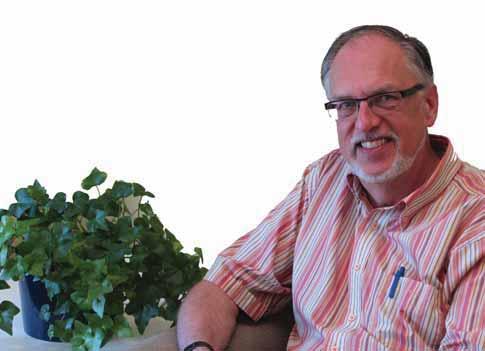




In May, David Wiebe of Canada was named executive director of the International Community of Mennonite Brethren (ICOMB). ICOMB, formed in 1990, is an association of MB conferences around the world, expressing their partnership in mission and ministry. Prior to taking on this assignment, Wiebe was executive director of the Canadian Conference of MB Churches. Wiebe is just the second person to serve ICOMB full-time, and he looks forward to the future of this growing and maturing organization. In this interview with Laura Kalmar, MB Herald editor, Wiebe talks about his new role. This interview is being published in both the Christian Leader and MB Herald, the Canadian conference English-language magazine.
When you accepted the role of part-time ICOMB interim executive secretary in 2011, did you imagine you’d be called to this position in a permanent capacity?
In summer 2010, my ICOMB colleagues said, “Dave, we think you should do this.” At that point, I only agreed

to serve as interim; I wanted due process. Then, (at our meeting in May) the guys stuck with their choice; they saw something in me. Other people may do things more independently, but I do things differently. My selection into ministry scenarios has always been discerned out of circumstances read into by community. If they call, who am I to resist God?
With the rise of the global south and given that the largest MB conferences are from India and DRC Congo, how will you lead ICOMB from a North American context?
I’m concerned about not retrenching into a global north mentality—with a North American set of expectations and assumptions.
What sort of assumptions?
How things get organized, how fast things get done, how directive we are. The upside is that I’m not very task-oriented [chuckle]. I’m more relationship-oriented, so my first question always is, “How’s everybody doing in the room?”
What else is ICOMB doing to mitigate North American influence?
Our chair, Rudi Plett, is from Paraguay. His value system and personality are very South American. As well, Dalton Reimer (education facilitator) is hoping to close out his work, so I’m actively looking for leadership for education initiatives from the Global South.
ICOMB’s new mission statement says it “exists to facilitate relationships and ministries which enhance the witness and discipleship of member conferences.” How are you planning to fulfill this mission?
We want to go gently into programmatic stuff in order to really focus on relationships. But sometimes, those relationships just find themselves.
For example, during the 2011 Higher Education Consultation, everybody was talking about the Japanese tsunami, since the consultation convened just after the disaster. When Yoshifumi Tanaka (Japanese representative) told his story, it touched the heart of Heinrich Klassen from Germany. Heinrich went home and raised about €27,000. It all developed out of relationship —outside any ICOMB programming. Crises often create the opportunity for partnership.
Another example comes from a congregation in the Bund Taufgesinnter Gemeinde conference in Germany. The church heard about the plight of leaders in Angola and discovered most Angolan pastors don’t own a Portuguese Bible. So, they made contact with the Bible Society in Lisbon and bought Bibles for the pastors. Because ICOMB exists, it has the capacity to facilitate these types of relationships.
ICOMB is 22 years old and is growing—with 20 partner conferences around the world and several others seeking to join. What excites you about the future of ICOMB?
ICOMB has taken off in the last couple of years because there’s been more definition (to the organization). We sent the message we were serious when we hired Victor Wall as executive secretary in 2005. And the ICOMB Confession of Faith has given us clear theological identity— it’s now been translated into about 12 languages.
In the next three years, I’d like to personally visit every one of our conferences, and part of the reason for those visits will be to conduct workshops around our Confession of Faith. It’s an excuse for more conversation—to build Mennonite Brethren fraternity and witness.
I’m excited about genuine theological dialogue and interaction. When I see how theologically as-
tute our partners around the world have become, I imagine possibilities. What (our global brothers and sisters) bring to a discussion about the Bible can help us, not just in North America but everywhere as long as we really listen to each other and God.
I’m also excited about love in ICOMB. “Love covers over a multitude of sins” (1 Peter 4:8). The relationships between our conference representatives create such a positive atmosphere. We really care for each other.
What do you see as the greatest challenges for ICOMB?
There’s always disparity between different areas of the world. We’re still uneven on a whole bunch of counts.
One of the big challenges is language. In our meetings, we translate on the fly—sentence by sentence—but there’s still too much information that gets dropped. If we’re going to have ideal theological conversation, we need language assistants. So, we’ve made a new commitment to use independent translators in the future.
The key is to create open space for ICOMB participants to have a voice. My hope is that everyone will feel a sense of freedom—of not being controlled by North American assumptions, standards, expectations or agendas. Ultimately, we want to be able to say the Holy Spirit had control of our meetings. The Holy Spirit uses (the challenges of) intercultural partnerships to help us break out of our boxes.
The kingdom of God is always full of surprises; we never know where it’s going to go or how it’s going to come to us. Partnerships are similar. We don’t know what’s going to connect or where those connections will lead.
How can Mennonite Brethren around the world best pray for you?
Wisdom is the first thing that comes to mind, the ability to focus on priorities. I need to manage my travel—all the fraternal visits I want to do—and the administration that needs to be done. It’s about figuring out how to best discharge my energies.
We make so many mistakes—known and unknown—that we need the power of the Holy Spirit. Please pray that God’s presence and Spirit would infuse my choices and my work.
In the end, I think God’s will is going to be done. I’m just management. It’s a gift, and I’m just watching it happen. I ask for prayer for whatever God wants to do.
If you’d like to sign up as an ICOMB prayer partner and receive David’s prayer updates, please email davidw@icomb.org.
Photo courtesy MB Herald
U.S. Mennonite Brethren gather in Omaha
Delegates approve recommendations, hear reports, enjoy evening programs
Conection 2012, the USMB delegate convention held July 25-28 in Omaha, Neb., is one for the history books for a number of reasons.
An Omaha first: The 2012 convention marks the first time the biennial USMB delegate convention was held in Omaha. In fact, the last time delegates traveled to the Central District for a national convention was in 1980 when they met in St. Paul, Minn.
The five USMB Omaha congregations did an excellent job hosting their 298 guests. Wearing black “One Mission” T-shirts, they served as greeters, provided childcare, organized and volunteered as on-site hosts for local service projects, served as workshop speakers and provided music during the two evening dinners.
A funding first: Delegates unanimously passed an historic $1 million budget that increases USMB’s investment
in church planting, national staff and promotion. In related action, delegates also approved a new strategy for determining the amount local congregations are asked to contribute to the national conference, bringing an end to the decades-long “norms” formula.
A dozen years ago, delegates to the 2000 convention approved a budget approaching $1 million and the following year the Board of Church Ministries, the executive board empowered to serve as the decision-making body between regular conventions, approved a 2001-02 budget of $1,087,245. This represented a vision for ministry that included an increase in church planting and the addition of a full-time national executive director and a team of parttime regional fundraisers. When a new decentralized fundraising strategy did not work as hoped, the budget was reduced and USMB ministries were downsized.
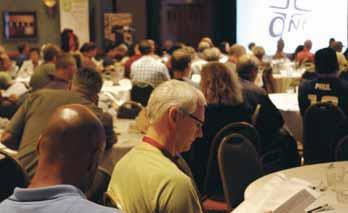
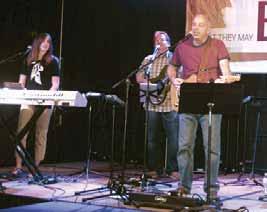

CHRISTIAN
LEADER
As was the case a decade ago, the prospect of seeing lives transformed by God as new U.S. Mennonite Brethren churches are planted is likely what prompted delegates to approve a $1 millionplus budget for the first time. The approved 2012-13 budget of $1,018,524 is an increase of 20 percent over the previous year.
While staff fundraising is slated to increase for the 2012-13 fiscal year, church giving is again pegged at $420,000. But USMB leaders hope replacing the “norms” approach to church giving with a proportional funding strategy will increase church contributions to USMB. Under the new plan, each USMB congregation is asked to forward 2.5 percent of their annual income, defined as tithes and offerings received by the congregation to support its general budget.
While delegates spent the two mornings hearing reports and processing business agenda, the afternoons offered practical opportunities. Workshops on a variety of topics were offered in the early afternoon followed by a service opportunity Friday and an informative bus tour of Omaha on Saturday. Evenings were intended to be inspirational and entertaining. Comedian Kenn Kington entertained the crowd Friday night, and Alex Kendrick, actor, screenwriter and pastor, spoke the next evening.
Musicians from The Bridge Bible Church of Bakersfield, Calif., served as the worship band for the week. Special music was provided Friday by Iglesia Agua Viva, a USMB Hispanic congregation from Omaha, and Saturday by the Chad Stoner Band.
In addition to the delegate convention, Conection 2012 included the National Pastors Conference held Wednesday through Thurs-
day prior to the delegate convention. The delegate convention and Pastors Conference shared the theme, “Be One,” taken from Jesus’ prayer for all believers in John 17:20-21.
Prayer was the focus of the pastors’ event with James Nicodem, pastor of Christ Community Church and author of Prayer Coach, as the keynote speaker. Various convention reports and both Conection 2012 evening speakers also referred to the convention theme.
For a full report on Conection 2012, visit www.usmb.org/christianleader—Connie Faber
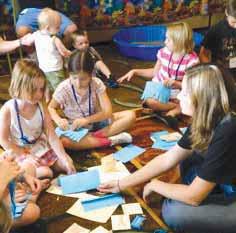

Previous Page—Left: Delegates took action on five recommendations.
Right: Musicians from The Bridge Bible Church in Bakersfield, Calif., singing at the Pastors Conference and Conection 2012. Below: Lunch was served buffet-style in the hotels' atrium. Above—Conection 2012 was a family event so child care and youth activites were provided.
CHRISTIAN LEADER
Delegates affirm increased budget
Church planting stories among highlights of Conection 2012 business sessions
While “business and reports” might not sound like exciting agenda, much of the inspiration of Conection 2012, the biennial USMB delegate convention held July 27-28, came from the morning sessions during which delegates heard from USMB staff and ministry partners and attended to business. They responded with frequent prayer and by approving an historic $1 million budget.
USMB Executive Director Ed Boschman set the tone in his passionate Friday morning address. “I want you to know that we have a vision,” he said. “We are asking God for a whatever-it-takes commitment to getting it done.”
Don Morris, director of Mission USA, USMB’s church planting and renewal arm, reminded delegates of that vision in his Saturday report: “To have an integral part in planting six new MB churches each year over the next 10 years and for the resources to get it done.”
Conection 2012 delegates and guests regularly burst into applause and “Amens” as church planters told stories of God at work through Mission USA projects in Littleton, Colo.; Kansas City, Mo.; Omaha, Neb.; Phoenix, Ariz.; Denver, Colo.; La Grulla, Texas; Boone, NC; and Clovis, Calif. Following the report, attendees surrounded Morris and church planters for prayer.
USMB staff members Aleks Borisov, Slavic ministries director; Connie Faber, editor of Christian Leader; and Myra Holmes, CL assistant editor and USMB social media coordinator, gave optimistic reports about their respective ministries.
While reports from various partners and ministries acknowledged challenges, a sense of optimism ruled. John Unger, board chair of MB Biblical
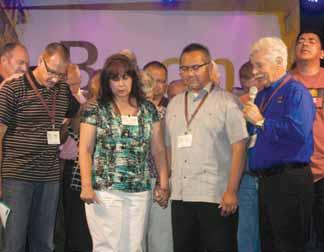
Seminary Inc., noted both grief and “great dividends” as the 35-year seminary partnership of the US and Canadian Mennonite Brethren comes to an end. A commemorative booklet highlighting MBBS history was distributed to those present.
Board of Faith and Life (BFL) Chair
Larry Nikkel set a positive tone for the upcoming Study Conference, planned for Jan. 24-26, 2013, which will address USMB Confession of Faith Articles 12 (Society and State) and 13 (Love and Nonresistance). He said that the conference will be marked by fair representation, listening and prayer.
“Sometimes family needs to step aside and talk,” he said, and asked for prayer for the event.
MB Mission outlined eight shifts in mission and as with the Mission USA report, convention attendees supported “front lines” workers with prayer.
Fresno Pacific University had the unique opportunity to mark a presidential transition at this national gathering. Retiring President D. Merrill
Ewert literally passed the baton to incoming President Pete Menjares during the university’s Saturday morning report. Once again, this highlight was marked with prayer for Menjares and his wife, Virginia.
In the Tabor College report, President Jules Glanzer said, “It’s a beautiful thing to watch as Tabor students belong and then become. Thank you for helping make it happen.” MB Foundation, Kindred Productions and Historical Commission also gave reports on
USMB Executive Director Ed Boschman (front right) offers a prayer for FPU President Pete Menjares and his wife, Virginia, (center), as FPU faculty, board members, staff, alumni and ministry partner representatives surround the couple in prayer.
how they continue their ministries of stewardship, resourcing and storytelling. The National Youth Committee announced four possible locations for the 2015 National Youth Conference.
The inspiring tone of the reports may have been key to delegates passing a 2012-13 budget of $1,087,245. That number—primarily providing for increases in church planting, national staff and promotion and marketing and for some expenses connected to the upcoming BFL Study Conference—represents a 20 percent increase and marks the first time delegates have approved a milliondollar budget.
In other business, delegates adopted a proportional funding model for financial support of USMB ministries.
USMB leaders hope the new strategy will increase the number of churches contributing to the budget—currently at only 30 percent.
Delegates also elected nominees to boards of USMB and partner ministries and approved revised bylaws that, among other things, refine the process by which the Leadership Board affirms nominees, redefine a quorum and allow the board to appoint two additional members. Finally, delegates approved a new Memorandum of Understanding allowing the Canadian Conference of MB Churches and the USMB to independently form their own Confessions of Faith and outlining how the leadership of the two national bodies will relate to one another—Myra Holmes
Evening speakers inspire laughter
Conection 2012 evening sessions proved to be both inspirational and entertaining. Friday evening comedian Kenn Kington (pictured left) had the audience laughing so frequently that tears flowed and sides hurt. Kington told humorous stories from his own life and shared his signature “isms”—statements he hears that aren’t quite right like “I am sweating like a bullet.”
The Friday evening program opened with dinner music provided in Spanish and English by the worship team (CL cover) from Iglesia Agua Viva, a Hispanic congregation in Omaha. USMB Omaha pastor and saxophonist Chad
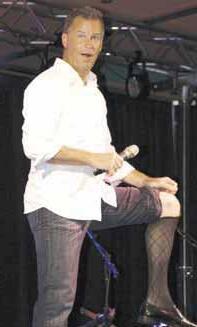
Stoner (pictured center) and his band gave a concert that showcased the group’s unique smooth jazz with elements of gospel and rhythm and blues.
The only standing ovation of Conection 2012 went to Saturday night’s speaker, Alex Kendrick (pictured right), founder of Sherwood Pictures, a ministry of Sherwood Baptist Church, Albany, Ga. As he told the story of his congregation’s decision to begin making Christian movies, Kendrick was both light-hearted—“I was doing my own makeup, which is terrible for a man to do”—and encouraging—“You can’t think big enough to out-think God.”—CF


Coming up short on the serve
Afternoons at Conection 2012 had a dual focus: practical applications for personal life and ministry and serving and exploring the city of Omaha.
Delegates could attend two 60minute workshops on topics that ranged from personal health to immigration to serving one’s community. Presenters included USMB staff members and pastors and staff from MB Mission, MB Foundation, Fresno Pacific Biblical Seminary, Tabor College and Mennonite Central Committee.
Stephen Stout, a member of Faith Bible Church and director of Good Neighbor Ministries, organized service opportunities Friday afternoon for 50-some volunteers who preregistered their interest in serving Omaha. Unfortunately, more than two-thirds chose to do something else. While Stout was very gracious about the low turnout, he had the unenviable task of phoning service sites to say that no volunteers would be coming. Nevertheless, USMB volunteers including Stout served at four sites: manning Olympic stations at Hope Center for Kids, organizing sports equipment at Hope Community Church, playing basketball at a residential facility for developmentally disabled adults and doing yard cleanup.
Learning about Omaha, once known as “the most wicked city in America,” was the focus of a twohour Saturday afternoon charter bus tour. Tour participants were able to see the different areas that are home to the city’s five Mennonite Brethren congregations: lower-middle class, fast-growing suburb and older historic communities.—Connie Faber
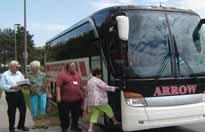







CHRISTIAN LEADER
CHRISTIAN LEADER
CHRISTIAN LEADER
Top: Tour goers board the bus for a two-hour cruise around Omaha. Side: Stephen Stout organized service opportunities for Conection 2012 volunteers. Bottom: Chris Regier, Enid, Okla., hands out watermelon seeds for an Olympic competition at Hope Center for Kids.
Teach us to pray
Pastors Conference focuses on prayer
When some 136 USMB pastors and spouses gathered July 25-26 prior to Conection 2012 for the National Pastors Conference, the emphasis was on prayer.
“I’m here to recommend prayer to you as a priority for our lives and our churches,” said speaker James Nicodem, author of Prayer Coach and pastor of Christ Community Church, St. Charles, Ill.
His three keynote addresses were centered in Scripture and closely followed material from Prayer Coach. Wednesday evening, Nicodem began with three directives on prayer from Acts 4:23-31: gather for prayer, worship with prayer and power up through prayer. Thursday morning, he used Acts 6 to talk about obstacles to effective prayer, and in his third address that evening, he noted that Jesus had a routine of prayer.
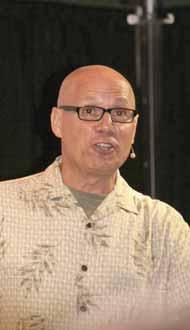
Nicodem said his aim was not inspiration but application, and he hit that target. Attendees often used the word “practical” to describe Nicodem’s input. Judging by informal comments, the pastors came away feeling better equipped to pray personally and to teach others to pray.
Attendees received further practical equipping through four Thursday afternoon workshops: Jason Ikner of Logos Bible Software presented a workshop on using Logos’ tools for Bible study and sermon preparation.
Lynn Jost, Fresno Pacific Biblical Seminary vice president and dean, and Brent Warkentin, senior pastor of First MB Church, Wichita, Kan., aimed to inspire better sermons in “Preparing to Preach.” Newly-announced LEAD Coaching Head Coach Jeff Nikkel, Mission USA Director Don Morris and USMB Executive Director Ed Boschman outlined the new LEAD Coach pastoral mentoring resource. Sue Nicodem, wife of James Nicodem, encouraged pastors’ wives in the most well attended workshop.
The Pastors Conference was peppered with prayer as attendees practiced what Nicodem preached. Times of musical worship led by John Szablowski and a worship team from The Bridge Bible Church, Bakersfield, Calif., were filled with a spirit of prayer. Wednesday night’s session ended with prayer in small groups. Thursday morning’s session was punctuated with short times of interaction and prayer assignments. A Thursday evening concert of prayer wrapped up the Pastors Conference. —Myra Holmes


James Nicodem spoke to USMB pastors about the importance of teaching and practicing prayer.
CHRISTIAN LEADER

Celebrating God’s Faithfulness Mission USA



Axiom Church, located in the west valley area of Phoenix, plans to launch a public service in January 2013. But ministry is already occurring! Celebrate their first baptism (pictured left, from June 2012) with church planters Gavin & Kendall Linderman and the church plant core team.














Don Morris Mission USA director

Praying for USMB church planters
As our USMB church planters lined up at the front of the assembly hall, I couldn’t help the lump in my throat or the tears at the edges of my eyes. They had just shared with the delegates of Conection 2012 in Omaha, Neb., a short tidbit of what God is doing with and through them.
I wish we could have had every Mennonite Brethren church planter present, but it was great to have the eight who could attend. They shared how God is entering into people’s lives as the church makes connections with them—people who don’t know Jesus yet. People who are broken and looking for answers.
The planters spoke of baptisms and how whole families have experienced dramatic change when they came to know Jesus. They shared about the need for facilities and core team helpers. They shared about God doing the seemingly impossible.
We have church planters who are from various walks of life, with varied backgrounds and life experiences. We have planters who are white, offwhite, tanned, brown and dark-skinned. (Note: We are on the cusp of seeing even more ethnic church plants in the near future). We have pastors who know how to plant in some of the most challenging cities in America—places like Portland, Ore., Phoenix, Ariz., Omaha, Neb., Kansas City, Mo., McAllen, Texas, and Aurora, Colo.
So, as I stood there on the stage preparing to pray for these selfless servants as they gathered in front of me, I realized how amazing it is to be a part of God’s work in the world. I realized how fortunate I am to have the privilege of working with these planters and our district church planting boards and district ministers to help plant churches
There are 270 new Christian martyrs every 24 hours in the world.

in areas where we’ve never been before. I realized how crucial this work is—to enter into places that Satan has previously controlled in order to bring the good news to people who need a Savior.
As I was praying over these men and women and for their families, I realized how vital it is that we pray and pray often for their protection. As they enter into enemy territory, the enemy is not going to take it lying down. Satan will do all he can to damage ministries, destroy families and launch obstacles. In fact, we have seen him do just that.
But we have power at our disposal. Paul says, “The weapons we fight with are not the weapons of the world. On the contrary, they have divine power to demolish strongholds” (2 Cor. 10:4). We’re in a battle for the sake of the gospel.
So as we seek to encourage our current church planters and look into the future and envision many more, it is imperative that we pray and pray often for them. That we “fight” on their behalf— with divine weapons of power.
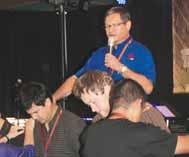

Martyr is defined as “believers in Christ who have lost their lives, prematurely, in situations of witness, as a result of human hostility.”
Source: International Bulletin of Missionary Research, 2011
CHRISTIAN LEADER
Finding new life @ The Springs
Nestled in the very southwest corner of Utah, St. George is a unique city that is home to SMCC
@The Springs, a USMB congregation. Close to 80 percent of the city’s 140,000 residents are of The Church of Jesus Christ of Latter-day Saints (LDS or Mormon) background.
The Springs began in the early 2000s as Desert Springs Church under church planter Tom Mertz. After struggling for several years, Mertz had a heartfelt “meeting-of-the-minds” with Pastor Paul Robie of South Mountain Community Church in Draper, Utah. The fledgling church officially joined the SMCC family in January of 2009 and became known as SMCC@The Springs. Mission USA, the USMB church planting and church renewal ministry, has supported The Springs since 2009 and is currently assisting with funds for Phil Wiebe’s position as associate pastor.
In early 2009, the church had an attendance of about 90 people. Since then, it has grown consistently at an annual rate of about 20 percent, hitting a high attendance of 460 in 2011. After moving from a cramped converted warehouse to a local high school a few months ago, numbers have drifted somewhat lower as people adjusted to the new location and new venue.
The most exciting part about The Springs’ threeyear growth is life transformations. Since early 2009, 38 people have been baptized, with over half of those being of LDS background. Moreover, the church has over 100 children, from babies to teens, indicating a dynamic family-oriented environment.
As people have come to know the true Jesus and not the falsely created “Jesus” of Mormonism, these public professions of faith have been dynamic, says Wiebe.
“The interesting thing with people who have an LDS history is that salvation rarely comes by a discussion and a prayer,” says Wiebe. “It usually happens over time. We have numerous attendees that remain LDS while coming to our church as they try to sort things out. It takes a while for them to process the truth of the gospel that they are hearing for the first time in their lives.”
Small groups are an important aspect of the church’s life-transformation ministry, and some of the groups have recently exploded in size. One small group that began with four couples grew to 16 couples and 30 children in the last month. Five of the couples have recently come out of the LDS. The group is now breaking off into four small groups.
The Springs has matured in its strategy for dealing with LDS realities, most recently utilizing some of the more mature previously LDS Christians to help with the transition of younger LDS believers. This is crucial because leaving the LDS church is a very difficult thing for individuals and families to do, says Wiebe.
“Imagine your children telling you they were leaving your church for the LDS church,” says Wiebe. “Take that emotion and then add the fact that families disown each other because of the transition, and that’s what we deal with. It brings new meaning to Christ’s words about leaving your father and mother on his account.”
— Mission USA

The Springs has celebrated 38 baptisms since 2009, including this group.
Geoff and Lori Taylor
Praying together
Iremember how our first date ended. I walked Lori to her door and in that awkward moment before we said goodnight, I held out my hand and asked her if I could pray with her before I left. She was pleasantly surprised and willingly agreed. I thanked God for our date and asked his blessing on each of us.
We were fortunate to have had that defining moment because it was the beginning of our prayer journey together. Since that first date, Lori and I have been praying together regularly. We keep it light and fun. But we’re committed, and it keeps us connected.
Spousal prayer is the key to family life and a fruit of spiritual maturity. But not all couples find it easy to share a moment of prayer. Asking some of our friends about their prayer life as a couple brought saddening results. Many godly men can’t seem to find the starting

wives and children, the best place to start is in their own personal devotions. Ask God for the opportunity and he will show you how to begin.
It is natural for a wife to want her husband to be a copartner in spiritual matters. Often, however, the wife’s expectation is different than that of her husband. If a wife begins to pressure her husband or becomes critical, she can unknowingly create a spiritual power struggle that is difficult for the couple to overcome. We’ve found that men who feel supported are more likely to embrace their leadership role.
If you’re interested in getting started, here are some ideas that have worked for us:
1. Try to connect for a few minutes each morning before departing or in the evening before bed (or both) to pray for your spouse, children and the events of

2. Let your prayer time be regular, meaningful and succinct. A good habit is hard to break.
3. Join together in prayer with your children, both young and old. What an example you will set.
4. Husbands should take the lead to initiate prayer at meals or other appropriate times throughout
5. Wives, follow your husband’s initiative without criticizing his approach or his technique.
6. Husbands, let your wife know she is important and joining together with her in prayer is a value
7. Men tend to be fact-based while women are more emotional. Taking a few minutes to discuss the details of your prayer concerns before you begin praying can prevent “informative” prayers.
8. Once you’re comfortable with daily prayer, consider praying over a common list of concerns. This might be weekly or at a predetermined time based on
9. Be flexible and patient as you develop a prayer
Finding a comfortable habit may not be easy in its early stages, but it is worth the effort. We encourage you to start today. That awkward moment at the beginning is well worth it!
Geoff and Lori Taylor have been praying together for over 13 years, most of them in Bakersfield, Calif., where they currently live. They have four adult children and one new son-in-law, whom they enjoy praying for and with whenever the opportunity presents itself.

Roger Fast
Shrugging off needs of others
Ifirst read Atlas Shrugged by Ayn Rand because a 1991 survey showed it among the most influential books in America; it was second only to the Bible. The premise of Atlas Shrugged is that capitalist entrepreneurs are carrying the burden of America’s economy on their shoulders, just like the mythical Atlas carried the earth on his shoulders. Tiring of government regulations and taxes, those entrepreneurs “shrug” off their burden, so to speak. They go on strike, forming their own secret utopian community. In so doing, they let the nation’s economic engines grind to a halt.
John Galt, Rand’s hero in the novel, hijacks the radio airwaves during the strike, and for an hour he harangues the nation (and the reader), speaking against government’s obstruction of the free market. It is a diatribe against taxation of the wealthy in order to provide for the poor. Galt is against any kind of self-sacrifice no matter how small, including the forced sacrifice represented by taxes.
The big problem as he sees it is that Christian values have poisoned the American economy. Galt ridicules those whose hero (Jesus) accepted the metaphorical label of “sacrificial lamb.” He blasts Jesus’ teaching that the poor should be helped because of their need. Pure capitalism requires that everyone act in self-interest. Equal value in return should be demanded for every service or commodity provided, with money, and gold in particular, as the standard of value. Through Galt and the other characters, Rand makes it clear that there is no place for altruism either in the national economy or in one’s personal life. There is no place for Jesus’ command to “love your neighbor as yourself.”
As I read this long novel, I felt the usual tug to identify with the hero. But I kept thinking about
Jesus’ saying that you can’t serve both God and mammon. Rand agrees with that, but she chooses mammon. I wondered if her book could really be that influential in a country that gives so much authority to the Bible. But a close look at some of our nation’s leaders confirms Rand’s influence.
Probably the most notable current example is Congressman Paul Ryan, chairman of the House Budget Committee and now vice presidential candidate. He has based his whole political philosophy around Atlas Shrugged. In a 2003 interview, Ryan praised Rand and added, “I give out Atlas Shrugged as Christmas presents, and I make all my interns read it.” After he defended his 2012 budget proposals in a Catholic university speech in April, church leaders criticized his budget as reflecting the values of Ayn Rand rather than the gospel of Jesus Christ.
We live in a world of competing values, and we have to make compromises. None of us can raise a family following completely the advice Jesus gave to the rich young ruler. On the other side, even a dedicated Randian wouldn’t make her child pay for room and board. At the national level, budgets have to balance many competing goals. It is my strong preference that my leaders make these tough decisions less under the influence of Rand and her demand that we love self and money and more under the influence of Jesus and his demand that we love God and neighbor.
Roger Fast, a member of College Community Church in Clovis, Calif., is a retired surgeon and was a missionary to Zaire from 1980 to 1984. He and Joan, his wife of 44 years, have four children and two grandchildren.

Carry a smartphone everywhere? Carry your Bible everywhere with these mobile Bible-reading apps.

Logos (Free): Includes a powerful suite of study tools; syncs with Logos Bible software for PC or Mac, available for separate purchase. Available for iOS and Android. Bible App (Free): Includes over 200 Bible translations and syncs with the free YouVersion Web site to allow users to bookmark, comment and share. Available for iOS, Android, Blackberry and Windows. BibleXpress ($30) and BibleXpress Lite ($3): Read Scripture in various translations, explore with a powerful search feature, then organize bookmarks and notes with this intuitive app. Available for iOS.


churchNotes
BAPTISM/MEMBERSHIP
Grace Sherman, Dana Waters and Jack Schuman were baptized July 8 and received as members of Birch Bay Bible Community Church, Blaine, Wash. Anna Odushkin, Yelena Odushkin, Joe Salas, Phil Davis and David and Charlene Wright were also received as members.
Pete Hall, Joe Miller, Jaymi Langer, Brandy Corn and Chase Sievers were baptized and received as members of Grace Bible Church, Gettysburg, SD, April 22. Dalton Storer and Jake Pullman were baptized May 6. Tanner Steuck, Connie Pearman, Jerry Hawkinson and Jake Pullman were received as members.
Edy Jost, Taylor Vogt, Erin Wiebe, Molly Wiebe, Lindsey Brazil, Devin Dick and Phillip Ediger were baptized April 22 at Hillsboro (Kan.) MB Church
Braydn Brown and Brendan Miller were baptized June 10 at Pine Acres Church, Weatherford, Okla. Jordan Penner was baptized May 6.
Katelyn Gossen and Cayden Gossen were baptized July 8 at Corn (Okla.) MB Church
Chacy Schafer, Jennifer Simmering, Donavon Simmering and Seth Wichert were baptized and received as members of Fairview (Okla.) MB Church April 1. Ashlee Bohnet, Kerri Pritchard, and Ginny Snyder were also received as members.
Saundra Goertz and Amanda Martens were baptized June 17 and received as members of Zoar MB Church, Inman, Kan Axiom Church, Phoenix, Ariz., celebrated their first baptism June 3. Axiom is a new church plant out of Copper Hills Church, Phoenix
James Lynch was baptized June 3 at Buhler (Kan.) MB Church. Travis Goertzen and Rachel Hagen were baptized and received as members May 13. Isaiah Clubb, Kala Corn, Justin Hershberger, Kaitlyn Pankratz, Joseph Schmidt and Shelby Schmidt were baptized and received as members May 20. Luke Ashauer, Kyla Knapp, Joanna Lynch, Rick and Lori Neufeldt and Jessica Schmucker were received as members.
Duren Weber, Sara Karber, Alison Friesen, Thomas Friesen, Joshua Buller, Calla Regier, Rachel Reimer, Sage Kroeker, Jessica Buller, Sam Buller, Dadrian Whiting, Micah Watson and Caedmon Delaplane were baptized and received as members of Enid (Okla.) MB Church April 15. Keith and Alice Reynolds
and Ricky and Valerie McCollum were received as members.
Christian Bloemhof, Garrett Bloemhof, Kaitlin Bloemhof, Matthew Bloemhof, Fernando Mulligan, Jacob Mulligan, Kristina Mulligan and Phillip Mulligan were baptized and received as members May 20 at Shafter (Calif.) MB Church
Diane Meisinger, Sharon Suderman and Riley Loewen were baptized May 20 and received as members of Ebenfeld MB Church, Hillsboro, Kan. Mike Meisinger and Dawn Suderman were received as members.
Brian Baker, Kimberly Moore, Sunny Buskirk, Christy Buskirk, Bishop Wright, KaiLeigh Archer, Kendall Archer, Emily Luther, Christian Cruz, Kaitlyn Martinez, Irelinde Jackson, Kai Penzhorn, Lynette Rasmussen, Cristin Szydlik, Serrah Bishop, Izabella Zavala, Cathey Davis, Bianca Dumas and Robert Ricks were baptized May 19-20 at South Mountain Community Church, Draper, Utah
CELEBRATIONS
Iglesia Agua Viva, Kingsburg, Calif., celebrated their 10-year anniversary July 8. Activities included a thank-you meal for Kingsburg (Calif.) MB Church, which hosts the Spanishlanguage congregation in their facility.
Iglesia Evangelico En Accion, Selma, Calif., celebrated their two-year anniversary May 20 with a block party featuring a Hispanic worship band and free hot dogs.
A Saturday evening BBQ dinner and storytelling kicked off the 50th anniversary celebration July 28-29 of Good News Christian Fellowship, Marion, Kan. Sunday’s activities included morning worship, a noon meal and group pictures.
WORKERS
Katie Gerber, Stacy Warkentin, Nathan Ehresman and Kaitlyn Brown served as summer interns at First MB Church, Wichita, Kan
Marc Clanton and Kevin Yarian served as summer youth interns at Laurelglen Bible Church, Bakersfield, Calif
Souk Sivongsay was installed July 15 as pastor for the Asian Grace congregation of Butler MB Church, Fresno, Calif
Sara Jo Waldron began serving July 1 as youth pastor at Hillsboro (Kan.) MB Church
Jay and Mandi Risner will be the new pastoral couple at Enid (Okla.) MB Church
Christie Baker served as a summer intern at College Community Church MB, Clovis, Calif

A new Freedom and Justice Tour
Mennonite Brethren teens from North Carolina toured significant sites in the civil rights movement for a 1,350mile “Freedom and Justice Tour” June 16-20. The 19 teens and five adults included participants from Boone (NC) MB Church; Laytown MB Church, Lenoir, NC; The Life Center, Lenoir; and First United Methodist Church, Lenoir. “Our desire was to learn about and experience the many barriers that people had to overcome during the segregation era in the South,” says Chris Eidse, pastor of Boone MB. “As leaders we wanted to see the youth inspired by the many biblical lessons from the civil rights movement.” Stops included: The Martin Luther King National Historical Site, Atlanta, Ga.; Birmingham Civil Rights Institute, Birmingham, Ala.; Kelly Ingram Park, Birmingham; and the National Civil Rights Museum, Memphis, Tenn. Students also did a service project at a ministry in Nashville, Tenn., watched the award-winning Freedom Riders documentary and met two of the original Freedom Riders, civil rights activists who rode interstate buses into the segregated South to test a Supreme Court ruling that banned racial discrimination in interstate travel. The group included a racial mix of teens, which Eidse says made the experience especially meaningful.
Sod Squad serves
At Bethany MB Church, Fresno, Calif., mowing the lawn is a ministry. Every Saturday morning, a team of 12-15 men called the “Sod Squad” descends upon the church’s 25-acre campus to mow, trim, plant, weed and repair. The Squad has been together for 25 years, and the age of the men involved ranges from 33 to 93. Squad members point out that their work helps create a positive first impression for newcomers and a safe playground for children. One says, “Not only does it provide good fellowship with other men but it also gives an opportunity to tithe time as well as money.” The volunteers have saved the church thousands of maintenance dollars over the years.

New Life in Ulysses
Ulysses (Kan.) MB Church has changed their name to New Life Church and given new life to their Sunday mornings with restructuring. Sunday school has been phased out. Worship now includes an Internet message by Andy Addis of CrossPoint Church, Hutchinson, Kan. Following worship, attendees gather in “Going Deeper” breakout sessions, and they reflect together on the morning’s sermon and Scripture. New Life is in the process of calling a campus pastor. —SDC newsletter

Larry King has retired after 22 years as pastor of Good News Christian Fellowship, Marion, Kan. Val Newton began serving as pastor Jan. 1, 2012.
Assefa Alemu, founding pastor of Ethiopian Christian Fellowship Church, Olathe, Kan., has retired.
Jordan Ringhofer is the new associate pastor at Kingsburg (Calif.) MB Church. He was the youth pastor at Kingwood Bible Church, Salem, Ore.
Blake and Carlin Buhrman have resigned their positions as youth pastor and worship pastor, respectively, at Belleview Community Church, Littleton, Colo
Wade French, Elison Hernandez, Marissa Hernandez, Steven Rutledge, Gabe Hughes, Ryan Loewen, Aaron Garza, Joel Leonard, Annelise Escobedo, Andrea Batista, Michael Gregory, Weston Smart, and Tony Petersen served as summer interns at Mountain View Community Church, Fresno, Calif
Steve Fast has resigned as pastor of adult discipleship at First MB Church, Wichita, Kan
Marlin Hiett was installed Aug. 26 by District Minister Tim Sullivan as senior pastor at Fairview (Okla.) MB Church. Hiett and his wife, Michelle, began their ministry in Fairview Aug. 1.
Coalt Robinson is serving as interim pastor at Bethel MB Church, Yale, SD
Scott Hicks was a summer intern at Ulysses (Kan.) MB Church
DEATHS
Agee, Joseph Jr., 87, former MB pastor, died June 6, 2012. Parents: Joseph and Voia (Brackney) Agee. Spouse: Verna Nikkel, deceased. Children: Joann Fast, Lynnette Huber, David; eight grandchildren; 12 greatgrandchildren.
Baerg, Henry R., 93, Chilliwack, BC, former MB pastor, died May 8, 2012. Parents: John J. and Margaret (Wiebe) Baerg. Spouse: Justina Anne Wiebe, deceased; Erika Miller. Children: Don, Eleanor, Sam, Charity, Paul, David; eight grandchildren; seven greatgrandchildren.
Block, David D., 91, Hesston, Kan., member of Hesston MB Church, died May 19, 2012. Parents: David C. and Sarah (Heinrichs) Block. Spouse: Sara Martens, deceased. Children: Jacqueline Albright, Jeffrey; four grandchildren; six great-grandchildren. Boehr, Norma Jean Neufeld, 83, Fairview, Okla., of Fairview MB Church, died Feb. 28,
2012. Parents: Harry C. and Justina (Heinrichs) Neufeld. Spouse: Bernhard “Ben” Boehr, Jr. Children: Douglas, Deborah. Boese, Laura, 93, Buhler, Kan., member of Buhler MB Church, died June 4, 2012. Parents: Henry and Helen (Bese) Wall. Spouse: Elden Boese, deceased. Children: Marlene Bussone, Ruth Brooks, Mary Ellen Kuehl; five grandchildren; seven great-grandchildren.
Buller, Marie, 73, Enid, Okla., member of Enid MB Church, died May 4, 2012. Parents: John P. and Katherina Rempel Buller. Delk, Evelyn, 93, Hillsboro, Kan., member of Hillsboro MB Church, died May 1, 2012. Parents: John W. and Martha (Schroeder) Warkentin. Spouse: Clifford Delk, deceased. Children: Kathy Schmidt, Margaret Tice, Jim, Bev Flaming, Pam Abbott; 10 grandchildren; 20 great-grandchildren.
Eitzen, Loretta Kathrene Martens, 85, Fairview Okla., of Fairview MB Church, died Dec. 4, 2011. Parents: Henry A. and Maria (Wall) Martens. Spouse: Wesley R. Eitzen. Children: Leland, Philip; eight grandchildren; one great-grandchild.
Eitzen, Naomi Ruth Vogt, 61, Fairview, Okla., of Fairview MB Church, died May 1, 2012. Parents: Cornelius and Esther (Loewen) Vogt. Spouse: Lee Eitzen. Children: Jenni Cabral, Jessica; one grandchild.
Falls, Dick, 75, Kingsburg, Calif., member of Kingsburg MB Church, died March 20, 2012. Parents: Angell and Gladys Falls. Spouse: Lillian Dahl. Children: Brian, Michael; five grandchildren.
Fast, Harry, 92, Kingsburg, Calif., charter member of Kingsburg MB Church, died Dec. 31, 2011. Parents: Jacob and Anna (Ratzlaff) Fast. Spouse: Viola Richert. Children: Roger, Harriet Groft, Pam Dourado, Patty Franz; 10 grandchildren; 10 great-grandchildren.
Fenstermacher, Robert James, 86, Hillsboro, Kan., member of Hillsboro MB Church, died May 5, 2012. Parents: Immanuel Fenstermacher and Bertha Hazzard. Spouse: Helen Ediger. Children: Barbara Villanueva, Mary Steketee, Sam; seven grandchildren; two great-grandchildren.
Harms, Pauline Schmidt, 82, Corn, Okla., member of Corn MB Church, died June 27, 2012. Parents: Emil and Eva (Teske) Schmidt. Spouse: Ogen Harms, deceased. Children: Margaret Adams, Linda Martin; six grandchildren; 12 great-grandchildren; one greatgreat-grandchild.
Heinrichs, Sylvia Bartel, 79, Fresno, Calif., member of Bethany MB Church, Fresno, died
Feb. 1, 2012. Parents: Sam and Mary Bartel. Spouse: Franklin Heinrichs. Children: Dale, Dean, Debbie Fries; five grandchildren.
Huebert, Evelyn Edna Epp, 88, Fairview, Okla., of Fairview MB Church, died March 26, 2012. Parents: Henry M. and Maria (Friesen) Epp. Spouse: Frank Huebert. Children: Allen, Frank, Sharon, Karen; 11 grandchildren; eight greatgrandchildren.
Koehn, Patricia Lynette, 69, Enid, Okla., member of Enid MB Church, died May 30, 2012. Parents: Menno and Martha (Warkentin) Voth. Spouse: Richard Koehn. Children: Lynette Crow, Mike; three grandchildren.
Kroeker, Katherine Marie, 88, Shafter, Calif., member of Shafter MB Church, died May 31, 2012. Parents: Cornelius K. and Elizabeth (Duerksen) Isaak. Spouse: Vernon Kroeker, deceased. Children: Janice Ollenburger, Dennis, Jay; four grandchildren; four great-grandchildren.
Lockie, Wanda Kay, 74, Fresno, Calif., member of North Fresno MB Church, died May 8, 2012. Parents: Edward and Molly Caughhorn. Spouses: Sam Nofziger, Sr., deceased; Bill Lockie. Children: Sam Nofziger Jr., Julie Ann Penn; two grandchildren.
Poppen, Naomi Ruth, 67, Bakersfield, Calif., member of Shafter MB Church, Shafter, Calif., died May 1, 2012. Parents: Abraham and Irma Fast. Spouse: Roger. Children: Alisa, Matt; two grandchildren.
Regier, Martha Marie Thiessen, 86, Henderson, Neb., member of Henderson MB Church, died June 11, 2012. Parents: Henry H. and Anna (Wiens) Thiessen. Spouse: Walter Regier, deceased. Children: Russell, Keith, Kenton; nine grandchildren; 10 great-grandchildren.
Schroeder, Judy E., 73, Canada, Kan., member of Hillsboro MB Church, died April 1, 2012. Parents: Jacob and Bertha (Epp) Ratzlaff. Spouse: JayDean Schroeder, deceased. Children: James, Joel; five grandchildren.
Toews, Mabel Gladys, 97, Enid, Okla., member of Enid MB Church, died May 8, 2012. Parents: Isaac and Nettie (Cornelsen) Wiebe. Spouse: George Toews. Children: Wilferd; four grandchildren; nine great-grandchildren; one greatgreat-grandchild.
Weems, Nicholas Gene, 21, Fairview, Okla., of Fairview MB Church, died Dec. 25, 2011.
Mother: Melissa Vione Weems.
Willems, Martha, 86, Hillsboro, Kan., of Hillsboro MB Church, died May 20, 2012. Parents: Peter D. and Maria (Ens) Willems.
reaching in
FELLOWSHIP
Neighborhood Church, Visalia, Calif., honored fathers June 17 with free A&W root beer floats. June 3 was “Children’s Day” at Dinuba (Calif.) MB Church, featuring a combined worship serv-
CLEARINGHOUSE
Local Church: Senior Pastor: Garden Valley Church, a Mennonite Brethren church in the diverse community of Garden City in southwest Kansas, is seeking a senior pastor to lead a group of approximately 150 believers. Our church has a heart for the community in which God has placed us, and a heart for missions, the world in which God has placed others. Send resumes and inquires to: Search Committee, c/o Garden Valley Church, 1701 N. 3rd Street, Garden City, KS 67846.
Local Church: Pastor of Worship: Belleview Community Church, Littleton, Colo., is seeking a part-time pastor of worship to partner with the senior pastor to plan music, worship and implement Sunday morning services and special occasions and to train volunteers serving in this area and to take the point in leading a contemporary worship band. This position provides a relatively flexible schedule. Hours/salary negotiable depending on time/ability of applicant. If interested send cover letter and resume to Mike Andrews at mandrews@belleviewchurch.org.
Local Church: Family Pastor: Belleview Community Church, Littleton, Colo., is searching for a part-time family pastor to provide leadership, oversight and an integrated approach to three areas: children (infants through 6th grade), youth (junior and senior high) and parenting. Please
Study Conference: The USMB Board of Faith and Life is hosting a Study Conference to be held Jan. 24-26, 2013, in Phoenix, Ariz. The conference will focus on Confession of Faith Article 12 (The Society and State) and Article 13
ice and recognition of graduates, followed by a picnic, swimming, softball and games.
Women from Shadow Lake Community Church, West Jordan, Utah, had a “slumber party” May 18-19.
WORSHIP
Attendees of Garden Valley Church, Garden City, Kan., held worship and a picnic at the zoo to mark Father’s Day June 17.
A community worship service June 22 in Minot, ND, remembered the flood there one year ago. Bible Fellowship Church pastor Duane Deckert was among the speakers. Volunteers presented potted plants to those in the neighborhood that was flooded.
The Grove Community Church, Fresno, Calif., is meeting on the Fresno Pacific University campus this summer while the elementary school in which they meet undergoes major equipment upgrades.
June 10 was Youth Sunday at Salem MB Church, Bridgewater, SD
On Father’s Day at Christ Community Church, Sioux Falls, SD, two fathers were selected to enjoy the service from the comfort of an easy chair.
contact Mike Andrews for more complete description of responsibilities. This position provides a relatively flexible schedule. Hours/salary negotiable depending on time/ability of applicant. If interested, send cover letter and resume to Mike Andrews at mandrews@belleviewchurch.org.
Planned Giving Advisor: MB Foundation is accepting applications for planned giving advisor. This person, based out of the Fresno, Calif., office, will represent MBF programs and services to individuals and ministries throughout the West Coast. The advisor will encourage charitable giving through current giving, estate planning and lifetime gift plans and provide customer service in all other areas of MBF work. MBF is a service agency of the U.S. Conference of MB Churches. Salary commensurate with training and experience. If interested, send a letter and resume to: Jon C. Wiebe, President/CEO, MB Foundation, PO Box 220, Hillsboro KS 67063 (jwiebe@mbfoundation.com)
Local Church: Associate Pastorfor Youth: Kingwood Bible Church, a Mennonite Brethren congregation in Salem, Ore., is accepting applications for a full-time Youth Pastor for an active youth ministry, serving 30-plus middle school and high school students. To apply, send a cover letter and resume to KBC Search Committee at kingwoodapp@yahoo.com.
(Peace and Nonresistance). All pastors, church leaders and others are invited to attend. Registration information is available at www.usmb.org/2013study-conference; early registration deadline is Dec. 15
Job Openings















































WILL POWER
LEAVING A LEGACY FOR THE NEXT GENERATION OF MBs
Many of us would say that we wish we had the power to make a difference. Yet together, as a Mennonite Brethren family, we are making a difference. Lives are being changed in Sioux Falls, Salt Lake City, Phoenix, Fresno and yes, even in Hillsboro, Corn, Reedley and elsewhere. Together, we are making a difference.




You also have the power to make a tremendous difference through a significant act of generosity, expressed through your will or trust. At death, many of us have the opportunity to make our largest single gift ever to support Kingdom work. Leaving a gift to USMB would make a significant difference in the lives of future Mennonite Brethren.
You have the power to make a difference… WILL POWER. Would you consider leaving a legacy for the next generation of MBs? Now that’s WILL POWER!
For a free guide to preparing a will or trust, or to learn about other planned giving options, contact a Planned Giving Advisor at 800.551.1547 or email by visiting MBFOUNDATION.COM/STAFF.

VAUGHN & TARYN JOST
DENVER CHURCH PLANTERS
YOUTH CONFERENCE SAN ANTONIO, TEXAS
SOUTH MOUNTAIN COMMUNITY CHURCH DRAPER, UTAH
